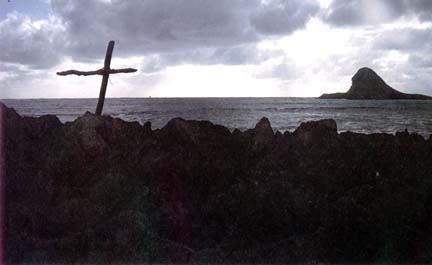by Greg Lehman
© all rights reserved
 Arthur,
M. and Flannery, T., 1985; The Kangaroo; Weldon, McMahon's Point,
Arthur,
M. and Flannery, T., 1985; The Kangaroo; Weldon, McMahon's Point,
Victoria.
Known to Palawa (Tasmanian Aboriginal) people as Tarner, a creation spirit
and ancestor to the 'first man', the kangaroo was part of a sacred landscape
where features such as stone outcrops, hills and mountains were gendered beings,
providing signs of a co-existent spiritual world. Through mythical kinship
obligations to the kangaroo, Aborigines were bound intimately to the land
as a home and to a complex Indigenous world. When the British invaded Tasmania,
these ties were fractured and the Palawa were forced into a new mythological
landscape of political struggle and an uncertain place.
The caption and reference for the cross image below is: (photo: Brian Prince in Prince 1992). PRINCE, B., 1992; A Midden of Antiquity, in Leatherwood 5:22-27)
Hibbs' Pyramid is a small off-shore island on Tasmania's west coast. It lies along the route followed by Umarrah and Parewarertar as they led G A Robinson up the south west coast in his quest to remove the Toogee people from their land. The Toogee knew the island as Meerim.
This image speaks strongly of the articulation between ancient and contemporary Tasmanian mythologies... the mythology of Evangelism (driven by the fear of death and the necessity of Christianity), which Robinson sought to instil in the Aborigines he met ) - is expressed through a lonely cross erected by forgotten sailors in submission to the death of one of their mates.
The mythology of the land is expressed by Meerim -
a figure created by the ancestor spirits ot the Toogee. Its meaning was constructed
over millenia by the Toogee and their predecessors as an expression of their
relationships with the land and their daily life. Today the Toogee have gone
and Meerim stands almost forgotten. 
The rock will outlast the cross as an icon - the spiritual identity of the rock is not just durable - it is intrinsic. The rock is imbued with spirit and sacredness. Non-Aborigines, who have no origin in this land, can also sense something of what is special about Meerim. Perhaps it is an echo of their own tribal spirit - harking back to distant ancestral lands. So how can we know the spirituality of Meerim today? Without the continuity of stories from the Toogee it has to be re-constructed by drawing on our own identities and imaginings. We bring about new meanings for Meerim. The spirit of the rock is re-kindled, along with new mythologies.
Greg Lehman, © all rights reserved
These images are reproduced for the purposes of criticism and review only. Please note that any further reproduction of these images without permission is a violation of copyright.
